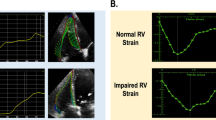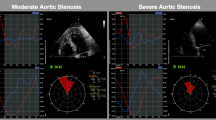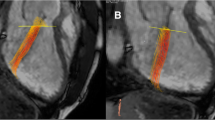Abstract
Objective
Speckle-tracking echocardiography (STE) deformation parameters detect latent LV dysfunction in chronic aortic regurgitation (AR) and are associated with outcomes. The aim of the study was to evaluate cardiac magnetic resonance (CMR) feature tracking (FT) deformation parameters in asymptomatic patients with AR and implications in outcomes.
Methods
Fifty-five patients with AR and 54 controls were included. Conventional functional CMR parameters, aortic regurgitant volume, and fraction were assessed. CMR-FT analysis was performed with a dedicated software. Clinical data was obtained from hospital records. A combined endpoint included all-cause mortality, cardiovascular mortality, aortic valve surgery, or cardiovascular hospital admission due to heart failure.
Results
Left ventricular (LV) mechanics is impaired in patients with significant AR. Significant differences were noted in global longitudinal strain (GLS) between controls and AR patients (− 19.1 ± 2.9% vs − 16.5 ± 3.2%, p < 0.001) and among AR severity groups (− 18.3 ± 3.1% vs − 16.2 ± 1.6% vs − 15 ± 3.5%; p = 0.02 for AR grades I–II, III, and IV). In univariate and multivariate analyses, circumferential strain (GCS) and global radial strain (GRS) but not GLS were associated with and increased risk of the end point with a HR of 1.26 (p = 0.016, 1.04–1.52) per 1% worsening for GCS and 0.90 (p = 0.012, 0.83–0.98) per 1% worsening for GRS.
Conclusions
CMR-FT myocardial deformation parameters are impaired in patients with AR not meeting surgical criteria. GLS decreases early in the course of the disease and is a marker of AR severity while GCS and GRS worsen later but predict a bad prognosis, mainly the need of aortic valve surgery.
Key Points
• CMR feature tracking LV mechanic parameters may be reduced in significant chronic AR with normal EF.
• LV mechanics, mainly global longitudinal strain, worsens as AR severity increases.
• LV mechanics, specially global radial and circumferential strain, is associated with a worse prognosis in AR patients.




Similar content being viewed by others
Abbreviations
- AR:
-
Aortic regurgitation
- CMR:
-
Cardiac magnetic resonance
- CMR-FT:
-
Cardiac magnetic resonance feature tracking
- GCS:
-
Global circumferential strain
- GLS:
-
Global longitudinal strain
- GRS:
-
Global radial strain
- LV:
-
Left ventricle
- RF:
-
Regurgitant fraction
- RV:
-
Regurgitant volume
- STE:
-
Speckle-tracking echocardiography
References
Dujardin KS, Enriquez-Sarano M, Schaff HV, Bailey KR, Seward JB, Tajik AJ (1999) Mortality and morbidity of aortic regurgitation in clinical practice: a long-term follow- up study. Circulation 99:1851–1857
Baumgartner H, Falk V, Bax JJ et al (2017) ESC Scientific Document Group. 2017 ESC/EACTS guidelines for the management of valvular heart disease. Eur Heart J 38:2739–2791
Nishimura RA, Otto CM, Bonow RO et al (2014) 2014 AHA/ACC guideline for the management of patients with valvular heart disease: executive summary: a report of the American College of Cardiology/ American Heart Association Task Force on Practice Guidelines. J Am Coll Cardiol 63:2438–2488
Bonow RO, Dodd JT, Maron BJ et al (1988) Long-term serial changes in left ventricular function and reversal of ventricular dilatation after valve replacement for chronic aortic regurgitation. Circulation 78:1108–1120
Pedrizzetti G, Claus P, Kilner PJ, Nagel E (2016) Principles of cardiovascular magnetic resonance feature tracking and echocardiographic speckle tracking for informed clinical use. J Cardiovasc Magn Reson 18:51
Ewe SH, Haeck ML, Ng AC et al (2015) Detection of subtle left ventricular systolic dysfunction in patients with significant aortic regurgitation and preserved left ventricular ejection fraction: speckle tracking echocardiographic analysis. Eur Heart J Cardiovasc Imaging 16:992–999
Smedsrud MK, Pettersen E, Gjesdal O et al (2011) Detection of left ventricular dysfunction by global longitudinal systolic strain in patients with chronic aortic regurgitation. J Am Soc Echocardiogr 24:1253–1259
Mizariene V, Grybauskiene R, Vaskelyte J, Jonkaitiene R, Pavilioniene J, Jurkevicius R (2011) Strain value in the assessment of left ventricular function and prediction of heart failure markers in aortic regurgitation. Echocardiography 28:983–992
Olsen NT, Sogaard P, Larsson HBW et al (2011) Speckle-tracking echo- cardiography for predicting outcome in chronic aortic regurgitation during conservative management and after surgery. JACC Cardiovasc Imaging 4:223–230
Alashi A, Mentias A, Abdallah A et al (2018) Incremental prognostic utility of left ventricular global longitudinal strain in asymptomatic patients with significant chronic aortic regurgitation and preserved left ventricular ejection fraction. J Am Coll Cardiol Img 11:673–682
Lee JC, Branch KR, Hamilton-Craig C, Krieger EV (2018) Evaluation of aortic regurgitation with cardiac magnetic resonance imaging: a systematic review. Heart 104:103–110
Schuster A, Hor KN, Kowallick JT, Beerbaum P, Kutty S (2016) Cardiovascular magnetic resonance myocardial feature tracking: concepts and clinical applications. Circ Cardiovasc Imaging 9:e004077. https://doi.org/10.1161/CIRCIMAGING.115.004077
Buss SJ, Breuninger K, Lehrke S et al (2015) Assessment of myocardial deformation with cardiac magnetic resonance strain imaging improves risk stratification in patients with dilated cardiomyopathy. Eur Heart J Cardiovasc Imaging 16:307–315
Heermann P, Hedderich DM, Paul M et al (2014) Biventricular myocardial strain analysis in patients with arrhythmogenic right ventricular cardiomyopathy (ARVC) using cardiovascular magnetic resonance feature tracking. J Cardiovasc Magn Reson 16:75. https://doi.org/10.1186/s12968-014-0075-z
Hinojar R, Fernández-Golfín C, González-Gómez A et al (2017) Prognostic implications of global myocardial mechanics in hypertrophic cardiomyopathy by cardiovascular magnetic resonance feature tracking. Relations to left ventricular hypertrophy and fibrosis. Int J Cardiol 249:467–472
Lancellotti P, Tribouilloy C, Hagendorff A et al (2013) Scientific Document Committee of the European Association of Cardiovascular Imaging. Recommendations for the echocardiographic assessment of native valvular regurgitation: an executive summary from the European Association of Cardiovascular Imaging. Eur Heart J Cardiovasc Imaging 14:611–644
Hudsmith LE, Petersen SE, Francis JM, Robson MD, Neubauer S (2015) Normal human left and right ventricular and left atrial dimensions using steady state free precession magnetic resonance imaging. J Cardiovasc Magn Reson 7:775–782
Kramer CM, Barkhausen J, Flamm SD, Kim RJ, Nagel E (2013) Society for Cardiovascular Magnetic Resonance Board of Trustees Task Force on Standardized Protocols. Standardized cardiovascular magnetic resonance (CMR) protocols 2013 update. J Cardiovasc Magn Reson 15:91. https://doi.org/10.1186/1532-429X-15-91
Schulz-Menger J, Bluemke DA, Bremerich J et al (2013) Standardized image interpretation and post processing in cardiovascular magnetic resonance: Society for Cardiovascular Magnetic Resonance (SCMR) board of trustees task force on standardized post processing. J Cardiovasc Magn Reson 15:35. https://doi.org/10.1186/1532-429X-15-35
Gabriel RS, Renapurkar R, Bolen MA et al (2011) Comparison of severity of aortic regurgitation by cardiovascular magnetic resonance versus transthoracic echocardiography. Am J Cardiol 108:1014–1020
von Knobelsdorff-Brenkenhoff F, Schunke T, Reiter S, Scheck R, Höfling B, Pilz G (2020, 2020) Influence of contrast agent and spatial resolution on myocardial strain results using feature tracking MRI. Eur Radiol. https://doi.org/10.1007/s00330-020-06971-x
Dobrovie M, Barreiro-Pérez M, Curione D et al (2019) Inter-vendor reproducibility and accuracy of segmental left ventricular strain measurements using CMR feature tracking. Eur Radiol 29:6846–6857
Maceira AM, Tuset-Sanchis L, López-Garrido M et al (2018) Feasibility and reproducibility of feature-tracking-based strain and strain rate measures of the left ventricle in different diseases and genders. J Magn Reson Imaging 47:1415–1425. https://doi.org/10.1002/jmri.25894
Andre F, Steen H, Matheis P et al (2015) Age- and gender-related normal left ventricular de-formation assessed by cardiovascular magnetic resonance feature tracking. J Cardiovasc Magn Reson 17:25. https://doi.org/10.1186/s12968- 015-0123-3
Hwang J, Kim SM, Park SJ et al (2017) Assessment of reverse remodeling predicted by myocardial deformation on tissue tracking in patients with severe aortic stenosis: a cardiovascular magnetic resonance imaging study. J Cardiovasc Magn Reson 19(1):80. https://doi.org/10.1186/s12968-017-0392-0
Myerson SG, d’Arcy J, Mohiaddin R et al (2012) Aortic regurgitation quantification using cardiovascular magnetic resonance association with clinical outcome. Circulation 126:1452–1460
Funding
The authors state that this work has not received any funding.
Author information
Authors and Affiliations
Corresponding author
Ethics declarations
Guarantor
The scientific guarantor of this publication is Covadonga Fernández-Golfín.
Conflict of interest
The authors of this manuscript declare no relationships with any companies, whose products or services may be related to the subject matter of the article.
Statistics and biometry
One of the authors has significant statistical expertise.
Informed consent
Written informed consent was obtained from all subjects (patients) in this study.
Ethical approval
Institutional Review Board approval was obtained.
Study subjects or cohorts overlap
Some study subjects or cohorts have been previously reported: Hinojar R, Fernández-Golfín C, González-Gómez A et al. Prognostic implications of global myocardial mechanics in hypertrophic cardiomyopathy by cardiovascular magnetic resonance feature tracking. Relations to left ventricular hypertrophy and fibrosis. Int J Cardiol. 2017: 249: 467-72.
Methodology
• retrospective
• diagnostic or prognostic study/observational
• performed at one institution
Additional information
Publisher’s note
Springer Nature remains neutral with regard to jurisdictional claims in published maps and institutional affiliations.
Rights and permissions
About this article
Cite this article
Fernández-Golfín, C., Hinojar-Baydes, R., González-Gómez, A. et al. Prognostic implications of cardiac magnetic resonance feature tracking derived multidirectional strain in patients with chronic aortic regurgitation. Eur Radiol 31, 5106–5115 (2021). https://doi.org/10.1007/s00330-020-07651-6
Received:
Revised:
Accepted:
Published:
Issue Date:
DOI: https://doi.org/10.1007/s00330-020-07651-6




